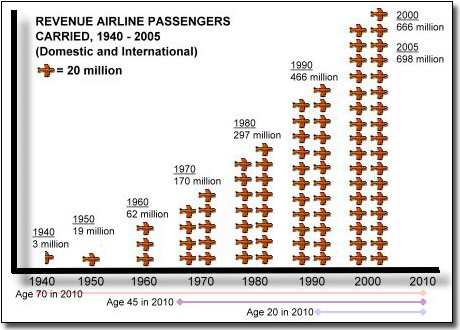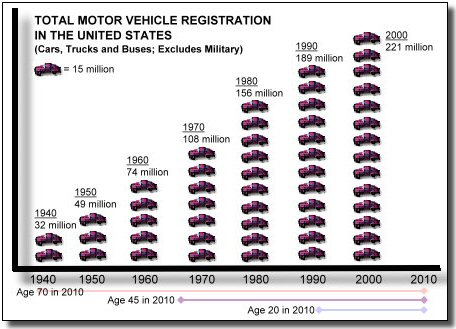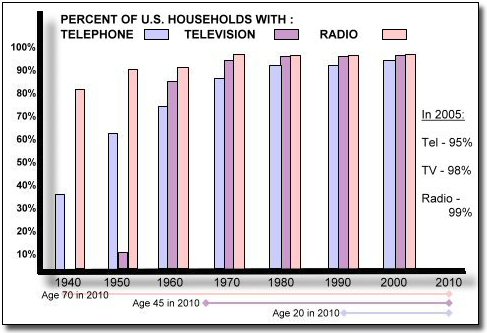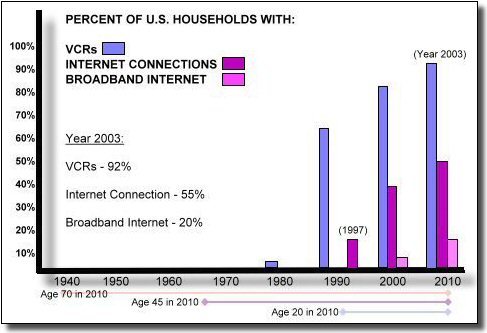 | ||||






 | ||||
|
WELCOME TO THE ESSAY ARCHIVES!
<< Part I
(June/July)
<< June
<< June
<< June
<< Part I
(June/July)
* * *
|
2007 Essays - July 2007 ESSAY SERIES - "PUTTING THE PIECES TOGETHER: TECHNOLOGICAL CHANGE - WHERE WE'VE BEEN, WHERE WE'RE GOING, AND A BRIEF INTRODUCTION TO THE FUTURE." For the past several years the essay section has focused on specific technologies including digital television, "green" cars and radio frequency identification (RFID). This year the essays take a step back to look, very simply, not only at where we've been in terms of technological change, but where we may be heading in the years to come. Each month's essay will also include a vignette of one inventor/invention, a short profile of something you may be seeing or hearing more of in the years to come. The summer schedule is follows: • July - Where We've Been • August - Where We're Going • September - A Brief Introduction to the Future July 2007 - Putting the Pieces Together: Technological Change - Where We've Been In the folklore of another culture, there is a character known paradoxically as a wise fool, an old man with a flowing beard sometimes depicted as riding a donkey. The following story is told about him: One day, as he was bent over in a field, working with his back to the street, a man in the roadway stopped and called out to him. "Hey, old man," he said. "How long will it take me to walk to the city from here?" The old man didn't reply, so the man in the street called out again. "Hello! I said, how long might it take me to walk to town from here?" Again their was no response. After calling out a third time and not receiving an answer, he assumed the bearded man was deaf and continued on his way. When he'd walked a few paces down the road, he heard a surprisingly robust voice coming from the field say, "Fifteen minutes! It will take you 15 minutes to get to town." The man on the street spun around to see the older man standing upright and facing the road. "Why didn't you reply when I asked you earlier?" the younger man demanded to know. "It's simple," said the wise man. "I had to see how fast you were walking." * * *
1940 - 2010 Over the last century, much of the change the world has seen has come from developments in medicine, agriculture, weaponry, transportation, communication and information. Weapons and medicine will not be discussed at all now, and many of the changes which have taken place in agriculture were discussed in the 2004 essay series on genetically modified foods. This month's essay will focus particularly on changes in transportation, communication and information since they are the areas most familiar to people in their daily lives. The time frame of 1940 - 2010 was selected to coincide with the ages of a majority of viewers visiting the site. At the bottom of each of the data charts below there are three lines. The lines are timelines for someone born in 1940 who will turn 70 in 2010, someone born in 1965 who will turn 45 in 2010 and someone born in 1990 who will turn 20 in 2010. The lines may be of some use in in gaining perspective of how things have changed during the course of your life or the lives of your family members. General Aspects of Change and Transportation There are a few general characteristics of technological change which can apply to just about any aspect of that change. Those characteristics include the fact that the pace of change tends to accelerate over time, there are usually both intended and unintended consequences of change, and that in this day and age new technologies tend to diffuse quickly around the world. Increasingly complex levels of technology also tend to decrease the time necessary to complete certain tasks. Take transportation, for example. In the 1800s, the best regular speed on land and water was about 10 mph. After the introduction of jet aircraft in the 1950s, regular passenger air travel speeds of 500 miles per hour or more became commonplace. This meant that a trip across the U.S. which could have taken four months in the 1800s could, after the 1950s, be made in less than four hours.(1)
So what are some of the changes in transportation which have taken place in the U.S. between 1940 and today? The chart above depicts the number of revenue (paying) passengers carried on both domestic and international flights by U.S. airlines. The number has grown from about 3 million in 1940 to nearly 700 million in 2004. (All data from the charts included has been compiled from the Statistical Abstract of the United States, volumes from 1950 - 2006. Details will be included in the bibliography section.) The chart below shows the increase in the number of motor vehicles registered in the U.S. during the same period. The number has risen from about 30 million in 1940 to well over 200 million today. Both of these changes are magnified by similar changes which have taken place in other industrialized countries over the same period, and which continue to take place in rapidly industrializing countries such as China.
This brings up another general characteristic of technological change - that the introduction of a new technology can bring about other changes far exceeding what could have been anticipated before the technology was introduced. The ability to move people and goods quickly and easily across the country and around the globe has brought more people in closer contact and has allowed for an ever-increasing volume of international trade. Changes have also been brought about in the infrastructure of all countries allowing the systems of transportation to exist and expand with consumer demand. Given all of the above, it is not difficult to understand how and why the world's petroleum reserves are gradually being depleted, or how and why the volume of carbon emissions has increased. A few potential solutions to transportation-related problems were discussed in the "Green Cars" essays of 2005. Many other related issues, such as alternative and renewable fuels and power generation, have yet to be discussed on the site. Communication and Information At the end of the 19th century people were becoming accustomed to the convenience of the first forms of communication over wire - telegraphs and the telephone. The two advances ushered in a new era for communication in the U.S. and around the world. For the first time the technologies uncoupled the direct relaying of messages from transportation and allowed the messages to be transmitted more rapidly than ever before. In addition, just as automobile and air travel brought enhanced personal and individual mobility, the telephone enhanced and mobilized greater interpersonal and private communication as it became more widely available for personal use. The telephone was invented in 1876, and by 1946 was found in more than half of all U.S. households. Commercial radio broadcasts began in the 1920s, and by the 1940 radio receivers were found in more than 80 percent of all U.S. households. Television followed afterwards in the 1950s, and today each of those technologies can be found in more than 90 percent of all U.S. homes (see chart below). Radio, and especially television, offered Americans something which in all of history had never been available - immediate access to news and information in the comfort of their homes. While newspapers had provided articles and still pictures for decades, radio and television offered new ways of accessing voices and moving pictures of events, in some cases even as they were happening. Today, at the beginning of the 21st century, people around the world face a more dizzying array of public and private communication and information tools and technologies. They are linked by, among other things, satellites, broadcast, cable and wireless networks, fiber optic cables and, of course, computers and the internet.
In early 2009, television will undergo its biggest transformation since the advent of color television. In February of that year the transition to digital television in the U.S. will be complete. All analog transmissions will cease, and TV sets without a digital tuner or set-top converter box will be unable to receive the all-digital signals. (The transition to digital television in the U.S. was the subject of the September 2005 and June 2006 essays.) This is one aspect of the merging, or "convergence," of digital information and communication technologies. Before, a television was a television, a computer was a computer, and a telephone was a telephone. Now it is possible to use your cell phone to connect to the internet, to connect to the internet via computer from a wide variety of wireless "hotspots," to receive internet service from your cable or telephone company, or to make a telephone call without actually using the telephone. Additional aspects of these changes were also included in last year's discussion of VOIP (Voice Over Internet Protocol).
Few, if any, of the changes in communication and information technologies would have been possible without the rapid changes which have taken place in the computer industry and the computing power which can be found in even the most simple desktop or laptop computers. In less than 10 years, the number of homes in the U.S. with an internet connection went from 0 to nearly 60%. Broadband (high-speed) DSL and cable internet connections also continue to work their way into U.S. homes, further enabling the development of more complex voice, data and video communication transmission.
This has been a brief look at some of the most visible changes in technology which have taken place over the last 60 - 70 years. The series will continue next month with an expanded discussion of some of these events and a look at where the changes will be leading in the near term. As mentioned earlier, each month's essay will also feature a brief profile of an inventor/invention. The July vignette is included below.
FOOTNOTES, CHART SOURCES AND BIBLIOGRAPHY FOOTNOTES - ESSAY (Click the asterisk at the end of each footnote to return to the paragraph of text which contained the reference.) 1. United States Senate, Committee on Foreign Relations, Worldwide and Domestic Economic Problems and Their Impact on the Foreign Policy of the U.S., 86th Congress, 1st Session, Washington D.C.: U.S. Government Printing Office, 1959, p. 8 * CHART SOURCES Please Note: All of the data for the essay charts is from various editions of U.S. Bureau of the Census, Statistical Abstract of the United States, Washington D.C. The year edition and table numbers are listed below. Chart 1: Revenue Airline Passengers Carried, 1940 - 2005
Chart 2: Total Motor Vehicle Registration in the U.S.
Chart 3: Percent of U.S. Households with Telephone, Television and Radio
Chart 4: Cellular Telephone Subscribers in the U.S.
Chart 5: Percent of U.S. Households with VCRs, Internet Connections and Broadband Internet
FOOTNOTES - VIGNETTE 1. Hypersonic Sound (HSS), Directed Audio Sound System, viewed at http://www.atcsd.com * 2. Helman, Christoper, "Now Hear This," Forbes, September 15, 2003, pp. 122 - 123* 3. "Contests and Shows," Popular Science, Vol. 270, No. 6, June 2007, p. 63* BIBLIOGRAPHY Birsic, Dorothy, Notes on Change, Vol. I, No. II, unpublished edition of monthly newsletter, October 1993. "Contests and Shows," Popular Science, Vol. 27, No. 6, June 2007, p. 63. Else, Liz, "We Hold These Freedoms to be Self Evident," New Scientist, April 24, 2004, pp. 46 - 49. Helman, Christopher, "Now Hear This," Forbes, Sept. 15, 2003, pp. 122 - 123. Hypersonic Sound (HSS), Directed Audio Sound System, viewed at http://www.atscd.com. U.S. Bureau of the Census, Historical Statistics of the United States, Colonial Times to 1970, Volumes 1 and 2. Washington D.C.: 1975. U.S. Census Bureau, Statistical Abstract of the United States. Years - 1954, 1970, 1971, 1975, 1987, 1992, 1997, 2002, 2006. Washington D.C.: Years listed. U.S. Senate, Committee on Foreign Relations, Worldwide and Domestic Economic Problems and Their Impact on the Foreign Policy of the United States, 86th Congress, 1st Session. Washington, D.C.: 1959.
To return to the top of the page, click here. To return to the essay archives, click here. Follow www.dorothyswebsite.org on TWITTER! Home | Poetry |
Essays | Free Concerts | Links | 2010 Extras |
About the Site |
|||
 | ||||
|
www.dorothyswebsite.org © 2003 - 2010 Dorothy A. Birsic. All rights reserved. Comments? Questions? Send an e-mail to: information@dorothyswebsite.org | ||||




 The picture on the left was taken many years ago on a trek in Nepal. The sign depicted was placed near path so as to give
trekkers some idea of the distances they needed to travel en route to their chosen destinations. Given that the distances were measured in hours and days, not kilometers and miles, certain assumptions were made about just how
fast someone might be walking. Unfortunately, there are few signs like this on the road of technological change. It is possible, though, to look at how change has taken place. By "retracing" the steps of change over time, it
is possible to think about how fast and in what direction we've been "walking." This first essay in the summer series will do that, albeit on a very limited scale.
The picture on the left was taken many years ago on a trek in Nepal. The sign depicted was placed near path so as to give
trekkers some idea of the distances they needed to travel en route to their chosen destinations. Given that the distances were measured in hours and days, not kilometers and miles, certain assumptions were made about just how
fast someone might be walking. Unfortunately, there are few signs like this on the road of technological change. It is possible, though, to look at how change has taken place. By "retracing" the steps of change over time, it
is possible to think about how fast and in what direction we've been "walking." This first essay in the summer series will do that, albeit on a very limited scale.




